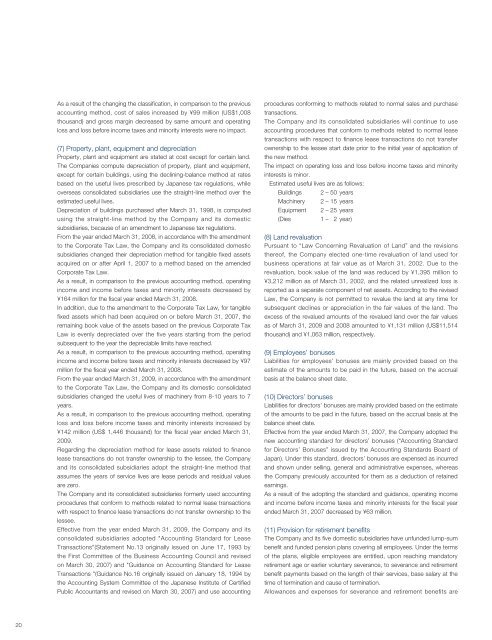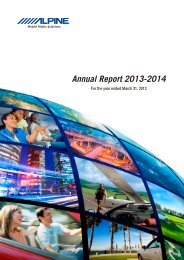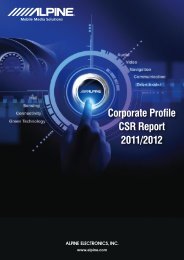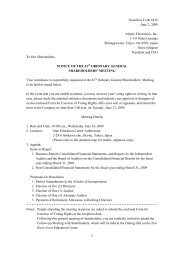PDF : 3518KB - Alpine
PDF : 3518KB - Alpine
PDF : 3518KB - Alpine
You also want an ePaper? Increase the reach of your titles
YUMPU automatically turns print PDFs into web optimized ePapers that Google loves.
As a result of the changing the classification, in comparison to the previous<br />
accounting method, cost of sales increased by ¥99 million (US$1,008<br />
thousand) and gross margin decreased by same amount and operating<br />
loss and loss before income taxes and minority interests were no impact.<br />
(7) Property, plant, equipment and depreciation<br />
Property, plant and equipment are stated at cost except for certain land.<br />
The Companies compute depreciation of property, plant and equipment,<br />
except for certain buildings, using the declining-balance method at rates<br />
based on the useful lives prescribed by Japanese tax regulations, while<br />
overseas consolidated subsidiaries use the straight-line method over the<br />
estimated useful lives.<br />
Depreciation of buildings purchased after March 31, 1998, is computed<br />
using the straight-line method by the Company and its domestic<br />
subsidiaries, because of an amendment to Japanese tax regulations.<br />
From the year ended March 31, 2008, in accordance with the amendment<br />
to the Corporate Tax Law, the Company and its consolidated domestic<br />
subsidiaries changed their depreciation method for tangible fixed assets<br />
acquired on or after April 1, 2007 to a method based on the amended<br />
Corporate Tax Law.<br />
As a result, in comparison to the previous accounting method, operating<br />
income and income before taxes and minority interests decreased by<br />
¥164 million for the fiscal year ended March 31, 2008.<br />
In addition, due to the amendment to the Corporate Tax Law, for tangible<br />
fixed assets which had been acquired on or before March 31, 2007, the<br />
remaining book value of the assets based on the previous Corporate Tax<br />
Law is evenly depreciated over the five years starting from the period<br />
subsequent to the year the depreciable limits have reached.<br />
As a result, in comparison to the previous accounting method, operating<br />
income and income before taxes and minority interests decreased by ¥97<br />
million for the fiscal year ended March 31, 2008.<br />
From the year ended March 31, 2009, in accordance with the amendment<br />
to the Corporate Tax Law, the Company and its domestic consolidated<br />
subsidiaries changed the useful lives of machinery from 8-10 years to 7<br />
years.<br />
As a result, in comparison to the previous accounting method, operating<br />
loss and loss before income taxes and minority interests increased by<br />
¥142 million (US$ 1,446 thousand) for the fiscal year ended March 31,<br />
2009.<br />
Regarding the depreciation method for lease assets related to finance<br />
lease transactions do not transfer ownership to the lessee, the Company<br />
and its consolidated subsidiaries adopt the straight-line method that<br />
assumes the years of service lives are lease periods and residual values<br />
are zero.<br />
The Company and its consolidated subsidiaries formerly used accounting<br />
procedures that conform to methods related to normal lease transactions<br />
with respect to finance lease transactions do not transfer ownership to the<br />
lessee.<br />
Effective from the year ended March 31, 2009, the Company and its<br />
consolidated subsidiaries adopted "Accounting Standard for Lease<br />
Transactions"(Statement No.13 originally issued on June 17, 1993 by<br />
the First Committee of the Business Accounting Council and revised<br />
on March 30, 2007) and "Guidance on Accounting Standard for Lease<br />
Transactions "(Guidance No.16 originally issued on January 18, 1994 by<br />
the Accounting System Committee of the Japanese Institute of Certified<br />
Public Accountants and revised on March 30, 2007) and use accounting<br />
procedures conforming to methods related to normal sales and purchase<br />
transactions.<br />
The Company and its consolidated subsidiaries will continue to use<br />
accounting procedures that conform to methods related to normal lease<br />
transactions with respect to finance lease transactions do not transfer<br />
ownership to the lessee start date prior to the initial year of application of<br />
the new method.<br />
The impact on operating loss and loss before income taxes and minority<br />
interests is minor.<br />
Estimated useful lives are as follows:<br />
Buildings 2 – 50 years<br />
Machinery 2 – 15 years<br />
Equipment 2 – 25 years<br />
(Dies 1 – 2 year)<br />
(8) Land revaluation<br />
Pursuant to “Law Concerning Revaluation of Land” and the revisions<br />
thereof, the Company elected one-time revaluation of land used for<br />
business operations at fair value as of March 31, 2002. Due to the<br />
revaluation, book value of the land was reduced by ¥1,395 million to<br />
¥3,212 million as of March 31, 2002, and the related unrealized loss is<br />
reported as a separate component of net assets. According to the revised<br />
Law, the Company is not permitted to revalue the land at any time for<br />
subsequent declines or appreciation in the fair values of the land. The<br />
excess of the revalued amounts of the revalued land over the fair values<br />
as of March 31, 2009 and 2008 amounted to ¥1,131 million (US$11,514<br />
thousand) and ¥1,063 million, respectively.<br />
(9) Employees’ bonuses<br />
Liabilities for employees’ bonuses are mainly provided based on the<br />
estimate of the amounts to be paid in the future, based on the accrual<br />
basis at the balance sheet date.<br />
(10) Directors’ bonuses<br />
Liabilities for directors’ bonuses are mainly provided based on the estimate<br />
of the amounts to be paid in the future, based on the accrual basis at the<br />
balance sheet date.<br />
Effective from the year ended March 31, 2007, the Company adopted the<br />
new accounting standard for directors’ bonuses (“Accounting Standard<br />
for Directors’ Bonuses” issued by the Accounting Standards Board of<br />
Japan). Under this standard, directors’ bonuses are expensed as incurred<br />
and shown under selling, general and administrative expenses, whereas<br />
the Company previously accounted for them as a deduction of retained<br />
earnings.<br />
As a result of the adopting the standard and guidance, operating income<br />
and income before income taxes and minority interests for the fiscal year<br />
ended March 31, 2007 decreased by ¥63 million.<br />
(11) Provision for retirement benefits<br />
The Company and its five domestic subsidiaries have unfunded lump-sum<br />
benefit and funded pension plans covering all employees. Under the terms<br />
of the plans, eligible employees are entitled, upon reaching mandatory<br />
retirement age or earlier voluntary severance, to severance and retirement<br />
benefit payments based on the length of their services, base salary at the<br />
time of termination and cause of termination.<br />
Allowances and expenses for severance and retirement benefits are<br />
20








